
©
2002 GTO, Inc.
R3000 INST
rev - 03/11/04
WARNING!
This equipment is similar to other gate or door equipment and meets or exceeds
Underwriters Laboratory Standard 325 (UL 325). However, gate equipment has
hazards associated with its use and therefore by installing this product the
installer and user accept full responsibility for following and noting the
installation and safety instructions. Failure to follow installation and safety
instructions can result in hazards developing due to improper assembly. You agree
to properly install this product and that if you fail to do so GTO, Inc. shall in no
event be liable for direct, indirect, incidental, special or consequential damages or
loss of profits whether based in contract tort or any other legal theory during the
course of the warranty or at any time thereafter. The installer and/or user agree to
assume responsibility for all liability and use of this product releasing GTO, Inc.
from any and all liability. If you are not in agreement with this disclaimer or do
not feel capable of properly following all installation and safety instructions you
may return this product for full replacement value.
READ ALL INSTRUCTIONS CAREFULLY AND COMPLETELY before
attempting to install and use this automatic gate operator. This gate operator
produces a high level of force. Stay clear of the unit while it is operating and
exercise caution at all times.
All automatic gate operators are intended for use on vehicular gates only.
This product meets and exceeds the requirements of UL 325, the standard which regulates gate operator safety,
as established and made effective March 1, 2000, by Underwriters Laboratories Inc.
Installation Manual for the
SINGLE Gate Operator System
FOR PROFESSIONAL INSTALLATION ONLY!
®
DC-SERIES
1-800-543-GATE (4283) • www.gtopro.com
®
DC-SERIES
WARNING
!
MOVING GATE
Can Cause Injury or Death
3121 Hartsfield Road • Tallahassee, Florida, USA 32303
Telephone GTO Sales: 1-800-543-GATE (4283) or (850) 575-0176 • Fax (850) 575-8912
or GTO Technical Service: 1-800-543-1236 or (850) 575-4144 • Fax (850)575-8950
www.gtopro.com

VEHICULAR GATE OPERATOR CLASS CATEGORIES
Residential Vehicular Gate Operator-Class I: A vehicular gate operator (or system) intended for use in a home
of one-to-four single family dwelling, or a garage or parking area associated therewith.
Commercial/General Access Vehicular Gate Operator-Class II: A vehicular gate operator (or system) intended
for use in a commercial location or building such as a multifamily housing unit (five or more single family units),
hotel, garages, retail store, or other building servicing the general public.
Industrial/Limited Access Vehicular Gate Operator–Class III: A vehicular gate operator (or system) intended
for use in an industrial location or building such as a factory or loading dock area or other locations not intended to
service the general public.
Restricted Access Vehicular Gate Operator–Class IV: A vehicular gate operator (or system) intended for use in
a guarded industrial location or building such as an airport security area or other restricted access locations not
servicing the general public, in which unauthorized access is prevented via supervision by security personnel.
The GTO/PRO® 3000 Gate Operator is intended for use with vehicular swing gates. The operator can be used in
Class I, Class II, Class III and Class IV applications.
FOR YOUR RECORDS
Please record the product serial number (located on the control box cover), and the date
and place of purchase in the spaces provided below. Refer to this information when
calling GTO for service or assistance with your automatic gate operator.
Serial Number ____________________ Date of Purchase ____________________
Place of Purchase ____________________
Remember to keep all receipts for proof of purchase.
Converting Metric Units to English Equivalents
When You Know Multiply By To Find Symbol
centimeters 0.3937 inches in. (or ")
meters 3.2808 feet ft. (or ')
kilograms 2.2046 pounds lb. (or #)
Converting English Units to Metric Equivalents
When You Know Multiply By To Find Symbol
inches 2.5400 centimeters cm
feet 0.3048 meters m
pounds 0.4535 kilograms kg
Converting Temperature
deg. Celsius (ºC x 1.8) + 32 deg. Fahrenheit ºF
deg. Fahrenheit (ºF-32) ÷ 1.8 deg. Celsius ºC
Conversion Chart

Gate Operator Class Categories -----------------------------------------------------------inside cover
Units and Standards Conversion Chart---------------------------------------------------inside cover
PLEASE READ THIS FIRST!------------------------------------------------- page iii
Important Safety Instructions -------------------------------------------------- page 1
Disconnecting the Operator -----------------------------------------------------------page 1
Important Safety Instructions for the Consumer -----------------------------------page 2
Secondary Means of Protection Against Entrapment -----------------------------page 5
Required Safety Precautions for Gates ----------------------------------------------page 6
Warning Signs and Labels ------------------------------------------------------------page 7
Installation-------------------------------------------------------------------------- page 8
Parts List ---------------------------------------------------------------------------------page 8
Technical Specifications --------------------------------------------------------------page 10
Installation Overview ---------------------------------------------------------------- page 11
Installation of the Mounting Hardware----------------------------------------------page 12
Mounting the Operator ----------------------------------------------------------------page 16
Installation of the Closed Position Stop ---------------------------------------------page 16
Mounting the Control Box ------------------------------------------------------------page 17
Connecting the Power Cable----------------------------------------------------------page 18
Powering the System ------------------------------------------------------------- page 19
Solar Chart ------------------------------------------------------------------------------page 19
Connecting the Transformer ----------------------------------------------------------page 19
Control Board Settings----------------------------------------------------------- page 22
DIP Switches----------------------------------------------------------------------------page 22
Setting the Closed Position -----------------------------------------------------------page 23
Obstruction Sensitivity ----------------------------------------------------------------page 24
Setting Your Personal Transmitter Code ------------------------------------ page 25
Installing the Receiver ----------------------------------------------------------- page 26
Connecting Additional Safety Devices ---------------------------------------- page 27
Connecting Accessories ---------------------------------------------------------- page 29
Push to Open Installation ------------------------------------------------------- page 30
Maintenance & Troubleshooting Guide-------------------------------------- page 33
Repair Service --------------------------------------------------------------------- page 35
Column Installation Information ---------------------------------------------- page 36
Accessory Catalog----------------------------------------------------------------- page 37
Table of Contents
KEEP THESE INSTRUCTIONS FOR FUTURE REFERENCE

PLEASE READ THIS FIRST!
iii
®
DC-SERIES
Thank you for purchasing a GTO/PRO® 3000 When correctly installed and properly used, your GTO/PRO® 3000
Operator will give you many years of reliable service. Please read the following information to ensure you have the
correct system for your particular needs. This manual will enable you to properly install your GTO/PRO® 3000
Automatic Gate Operator.
The GTO/PRO® 3000 Operator
is designed for installation on a pull-to-open single leaf gate (gates that open into
the property). By purchasing an accessory bracket, the GTO/PRO® 3000 Operator can accommodate a push-to-
open single leaf gate (gates that open out from the property). The gate must not exceed 16 feet in length (per leaf) nor
weigh more than 650 pounds (per leaf) (please see Technical Specifications on page 10). The GTO/PRO® 3000
Operator can be used on vinyl, aluminum, chain link, farm tube, and wrought iron gates. Use on solid (wood) gates is
not recommended. Solid surface gates have a high resistance to the wind. If the wind is strong enough, the operator
will obstruct and stop.
The GTO/PRO® 3000 Operator accommodates extra transmitters, digital keypads, solar panels, push buttons,
automatic gate locks, and other access control products. These optional accessories (see the enclosed GTO/PRO®
Accessory Catalog) are available.
The GTO/PRO® 3000 Operator features adjustable obstruction sensing. This safety feature makes the gate stop
and reverse direction within 2 seconds when it comes in contact with an obstruction. MIN is the factory setting;
meaning the gate will exert the minimum force on an obstruction before it stops and reverses direction.
The GTO/PRO® 3000 Operator also has an adjustable auto-close feature. After the gate reaches the fully open
position, it can be set to remain open up to 120 seconds before automatically closing. Pressing the transmitter button
at any time after the gate opens fully will cause it to close immediately. OFF is the factory setting; meaning the gate
will stay open until you press the transmitter (or keypad, etc.) again.
Please call GTO at (800) 543-GATE [4283] or (850) 575-0176 for more information about our GTO/PRO®
professional line of gate operators and accessories. Our Sales Department will be glad to give you the name and phone
number of a GTO/PRO® dealer near you.
BEFORE YOU BEGIN TO INSTALL YOUR AUTOMATIC GATE OPERATOR:
Read these instructions carefully and completely to become
familiar with all parts and installation steps.
You must read the installation manual for detailed instructions on
gate operator safety and proper use of the gate operator.

1
IMPORTANT SAFETY INSTRUCTIONS
Because automatic gate operators produce high levels of force, consumers need to know the potential hazards associated with
improperly designed, installed, and maintained automated gate operator systems. Keep in mind that the gate operator is just
one component of the total gate operating system. Each component must work in unison to provide the consumer with
convenience, security, and safety.
This manual contains various safety precautions and warnings for the consumer. Because there are many possible
applications of the gate operator, the safety precautions and warnings contained in this manual cannot be completely
exhaustive in nature. They do, however, provide an overview of the safe design, installation, and use of this product.
CAREFULLY READ AND FOLLOW ALL SAFETY PRECAUTIONS, WARNINGS, AND INSTALLATION
INSTRUCTIONS TO ENSURE THE SAFE SYSTEM DESIGN, INSTALLATION, AND USE OF THIS PRODUCT.
Precautions and warnings in this manual are identified with this warning symbol. The symbol identifies conditions
that can result in damage to the operator or its components, serious injury, or death.
Because GTO automatic gate operators are only part of the total gate operating system, it is the responsibility of the
consumer to ensure that the total system is safe for its intended use.
Disconnecting the Operator
1. Turn control box power switch OFF.
2. Remove hairpin clip, clevis pin, and bushing
from either the front or rear mounting point.
3. Remove the opener from the mount.
The gate can be opened and closed manually
when the operator is disconnected.
NOTE: Substitute a Pin Lock for the clevis pin on the front
mount of the gate operator to prevent unauthorized removal of
the operator from the gate (see Accessory Catalog).
To Manually Open and Close the
Gate, Follow the Procedure Below:
CAUTION: The gate will move freely and uncontrolled when the gate operator is
removed from the gate. ONLY disconnect the operator when the control box power
switch is OFF and the gate is NOT moving.
Clevis Pin
Hairpin Clip
Gate Bracket
Front Mount
Bushing

2
IMPORTANT SAFETY INSTRUCTIONS
For The Consumer
WARNING: To reduce the risk of injury or death:
1. READ AND FOLLOW ALL INSTRUCTIONS. Failure to meet the requirements set forth in the instruction
manual could cause severe injury and/or death, for which the manufacturer cannot be held responsible.
2. When designing a system that will be entered from a highway or main thoroughfare, make sure the system is placed
far enough from the road to prevent traffic congestion.
3. The gate must be installed in a location that provides adequate clearance between it and adjacent structures when
opening and closing to reduce the risk of entrapment. Swinging gates must not open into public access areas.
4. The gate and gate operator installation must comply with any applicable local codes.
I. Before Installation
1. Verify this operator is proper for the type and size of gate, its frequency of use and the proper class rating.
2. Make sure the gate has been properly installed and swings freely in both directions. Repair or replace all worn or
damaged gate hardware prior to installation. A freely moving gate will require less force to operate and will
enhance the performance of the operator and safety devices used with the system.
3. Review the operation of the system to become familiar with its safety features. Understand how to disconnect the
operator for manual gate operation (see page 1).
4. This gate operator is intended for vehicular gates ONLY. A separate entrance or gate must be installed for
pedestrian use (see page 6).
5. Always keep people and objects away from the gate and its area of travel. NO ONE SHOULD CROSS THE
PATH OF A MOVING GATE.
6. Pay close attention to the diagram below and be aware of these areas at all times.
Entrapment
Zones for a
Pull-To-Open
Application
Gate in the
Open Position
ZONE 2
ZONE 3
ZONE 4
ZONE 5
Driveway
ZONE 1

3
IMPORTANT SAFETY INSTRUCTIONS
Moving Gate
Area
Driveway
10'
10'
10'
10'
NEVER INSTALL
any control device
within gray area
Pull-To-Open
Application
Entrapment Zones for a proper Pull-To-Open installation:
Zone 1 – leading edge of the gate and the fence post.
Zone 2 – between the gate and the gate post.
Zone 3 – the path of the gate.
Zone 4 – the space between the gate in the open position and any object such as a wall, fence, tree, etc.
Zone 5 – pinch points between the opener and gate or post.
II. During Installation
1. Install the gate opener on the inside of the property and fence line. DO NOT install an opener on the outside of the
gate where the public has access to it.
2. Be careful with moving parts and avoid close proximity to areas where fingers or hands could be pinched.
3. Devices such as contact sensors (safety edges) and non contact sensors (photo beams) provide additional protection
against entrapment.
4. If push buttons or key switches are installed, they should be within sight of the gate, yet located at least 10 feet from
any moving part of the gate (see diagram below). Never install any control device where a user will be tempted to
reach through the gate to activate the gate opener.
5. Do not activate your gate opener unless you can see it and can determine that its area of travel is clear of people,
pets, or other obstructions. Watch the gate through its entire movement.
6. Secure outdoor or easily accessed gate opener controls in order to prohibit unauthorized use of the gate.

4
IMPORTANT SAFETY INSTRUCTIONS
III. After Installation
1. Attach the warning signs (included) to each side of the gate to alert the public of automatic gate operation. It is
your responsibility to post warning signs on both sides of your gate. If any of these signs or warning decals become
damaged, illegible or missing, replace them immediately. Contact GTO for free replacements.
2. The gate is automatic and could move at any time, posing a serious risk of entrapment. No one should be in contact
with the gate when it is moving or stationary.
3. Do not attempt to drive into the gate area while the gate is moving; wait until the gate comes to a complete stop.
4. Do not attempt to "beat the gate" while the gate is closing. This is extremely dangerous.
5. Do not allow children or pets near your gate. Never let children operate or play with gate controls. Keep the
remote controls away from children and unauthorized users; store controls where children and unauthorized users do
not have access to them.
6. KEEP GATES PROPERLY MAINTAINED. Always turn power to operator OFF before performing any
maintenance. Clean the push-pull tube with a soft, dry cloth and apply silicone spray to it at least once per month.
7. Service the gate and gate operator regularly. Grease hinges, spray push pull tube with high quality silicon spray and
replace the battery every 3-5 years.
8. To operate this equipment safely, YOU must know how to disconnect the operator for manual gate operation
(see page 1). If you have read the instructions and still do not understand how to disconnect the operator, contact
the GTO Service Department.
9. Disconnect the operator ONLY when the power is TURNED OFF and the gate is NOT moving.
10. Make arrangements with local fire and law enforcement for emergency access.
11. Distribute and discuss copies of the IMPORTANT SAFETY INSTRUCTIONS section of this manual with all
persons authorized to use your gate.
12. IMPORTANT: Save these safety instructions. Make sure everyone who is
using or will be around the gate and gate operator are aware of the dangers
associated with automated gates. In the event you sell the property with the
gate operator or sell the gate operator, provide a copy of these safety
instructions to the new owner.
Should you lose or misplace this manual, a copy can be obtained by
downloading one from the GTO/PRO® web site (www.gtopro.com), by
contacting GTO, Inc., at 3121 Hartsfield Road, Tallahassee, Florida 32303 or
by calling 1-800-543-4283 and requesting a duplicate copy. One will be
provided to you free of charge.

5
IMPORTANT SAFETY INSTRUCTIONS
ENTRAPMENT ALARM (UL 325; 30A.1.1A)
The GTO/PRO® 3000 Automatic Gate Operator is designed to stop and reverse within 2 seconds when the gate
comes in contact with an obstruction. Additionally, these operators are equipped with an audio entrapment alarm
which will activate if the unit obstructs twice while opening or closing. This alarm will sound for a period of 5
minutes, or until the operator receives an intended signal from a hardwired entry/exit source (e.g. push button
control or keypad) and the gate returns to a fully open or fully closed position. Turning the power switch on the
control box OFF and back ON will also deactivate the alarm. Wireless controls such as transmitters and wireless
keypads will not deactivate the alarm.
Secondary Means of Protection Against
Entrapment
As specified by Gate Operator Safety Standard, UL 325 (30A.1.1), automatic gate operators shall have an inherent
entrapment sensing system, and shall have provisions for, or be supplied with, at least one independent secondary means to
protect against entrapment. The GTO/PRO® 3000 utilizes Type A, an inherent (i.e., built-in) entrapment sensing system as
the primary type of entrapment protection. Also, the GTO/PRO® 3000 has provisions for the connection of Type B2
protection to be used as the secondary type of entrapment protection, if desired.
1. For gate operators utilizing a contact sensor (e.g., safety edge sensor– Type B2) in accordance with UL 325 (51.8.4 [i]):
A. One or more contact sensors shall be located at the leading edge, bottom edge, and post edge, both inside and
outside of a vehicular swing gate system.
B. A hard wired contact sensor shall be located and its wiring arranged so that the communication between the
sensor and the gate operator is not subjected to mechanical damage.
C. A wireless contact sensor such as one that transmits radio frequency (RF) signals to the gate operator for
entrapment protection functions shall be located where the transmission of the signals are not obstructed or
impeded by building structures, natural landscaping or similar obstruction. A wireless contact sensor shall
function under the intended end-use conditions.
Vehicular Gate
Leading Edge Contact Sensor
on both sides of the gate
Bottom Edge Contact Sensor
on both sides of the gate
Post Edge Contact Sensor
on both sides of the gate

6
IMPORTANT SAFETY INSTRUCTIONS
Install Warning Signs
Entrapment Protection
GTO’s inherent obstruction settings, even when properly adjusted, may not be sensitive enough to prevent bodily injury in
some circumstances. For this reason, safety devices such as safety edge sensors (or photoelectric sensors), which stop and
reverse gate direction upon sensing an obstruction, are suggested for enhanced protection against entrapment.
Required Safety Precautions for Gates
Warning Signs
The warning signs (at right) must
be installed on both sides of the
gate (see page 7 for details).
Warning signs alert people of automatic gate operation and are required when installing the GTO/PRO® 3000 Automatic
Gate Operator. Furthermore, a walk-through gate must be installed if pedestrian traffic is expected near the vehicular gate.
We recommend using the GTO Bulldog Pedestrian Gate Lock (Call the GTO Sales Department) for controlled access.
1. KEEP CLEAR! Gate may move at any time.
2. Do not allow children to operate gate or
play in gate area.
3. This gate is for vehicles only. Pedestrians
must use a separate entrance.
Moving Gate Can Cause
Injury Or Death
WARNING
!
Warning Sign
Pedestrian Gate
Bulldog Pedestrian
Gate Lock
Vehicular Gate
Contact Sensor
(recommended, not included)
Contact Sensor
(recommended, not included)
Contact Sensor
(recommended, not included)
(recommended, not included
)

7
IMPORTANT SAFETY INSTRUCTIONS
These warning labels should be found
at the locations specified below.
If any of them are missing,
immediately contact GTO for
replacements.
!
Warning signs (2 enclosed) to be installed on each side
of the gate (3–5 feet above the bottom of the gate)
Maximum Gate: 650 lb. (294.8 kg); 16 ft. (4.8 m)
Voltage: 12 Vdc; Frequency: 0 Hz; Power: 40 W
Class I, II, III and IV Vehicular Swing Gate Operator.
Serial Number: XXXXXXXXXX
#xxxxxxx
Conforms to UL 325 STANDARDS
TO MANUALLY OPEN AND CLOSE THE GATE:
1. Turn control box power switch OFF.
2. Disconnect front or rear mount from gate bracket.
3. Pull operator away from front or real mounts.
DC SW-3000 SERIES
GTO, Inc. Ta llahassee, Florida USA
Disconnect operator ONLY when the control box power
switch is OFF and the gate is NOT moving.
L
I
S
T
E
D
US
C
Product identification and manual operation instruction
label (1) installed on control box cover
Logo and warning labels (2) installed on each side of operator housing.
1. KEEP CLEAR! Gate may move at any time.
2. Do not allow children to operate gate or play in
gate area.
3. This gate is for vehicles only. Pedestrians must
use separate entrance.
WARNING
!
MOVING GATE
Can Cause Injury or Death
®
DC-SERIES
1-800-543-GATE (4283) • www.gtopro.com

8
Single Gate Operator Parts List
Operator and Mounting Hardware
Hairpin Clip (2)
3/8" x 1-1/4" Clevis Pin (2)
5/16" x 1-3/4" Bolt (1)
3/8" x 2" Bolt (1)
3/8" x 3" Bolt (2)
3/8" x 8" Bolt (4)
8" Nylon Cable Tie (14)
3/8" Washer (9)
3/8" Lock Washer (7)
5/16" Washer (1)
3/8" Nut (7)
5/16" Nut (1)
Hardware
Gate Operator (1)
w/ 6' Power Cable
Gate Bracket (1)
Post Pivot Bracket (1)
Customer Support Card (1)
Post Bracket (2)
Closed Position
Stop Plate (1)
2" Receiver Mounting Screw (5)
®
E
-
Z
G
A
T
E
O
P
E
N
E
R
3/8" Bushings (2)

9
Single Gate Operator Parts List (continued)
Control Box and Electrical Components
ON/OFF
Transformer (1)
Battery (1)
Control Box (1)
Warning Signs (2)
GTO Transmitter(1)
1. KEEP CLEAR! Gate may move at any time.
2. Do not allow children to operate gate or
play in gate area.
3. This gate is for vehicles only. Pedestrians
must use a separate entrance.
Moving Gate Can Cause
Injury Or Death
WARNING
!
Receiver (1)
Tools Needed
• Power Drill
• Open End Wrenches —
3
/8",
7
/16",
1
/2", and
9
/16"
•
3
/8" Drill Bit
• Hacksaw or Heavy Duty Bolt Cutters
• Small (Flat Bladed) Screwdriver
• Phillips Screwdriver
• Tape Measure
• Level
• Wire Strippers
• C-Clamps — small, medium, and large
• Center Punch
• Extra person will be helpful
YOU MAY ALSO NEED THESE ITEMS BEFORE YOU BEGIN THE INSTALLATION
(Some of these items can be found in the Accessory Catalog page 37):
•Low voltage wire will be needed to run from the transformer to the control box; length depends upon the distance between
the transformer power supply and the control box. See Powering the System on page 19, and the Accessory Catalog.
• If your gate is more than 1000' away from an ac power source you will need to use at least 5 watts of solar charging power
to trickle charge the battery. See the Accessory Catalog.
• If your fence post is made of wood and is less than 6" in diameter or 6" square, see page 12.
• If your fence post is larger than 6" in diameter you will need threaded rods or carriage bolts longer than 8". See page 15.
• PVC conduit.
• If you have thin walled tube or panel gates, see Recommended Reinforcement Examples on page 12.
• Depending on the type of gate, a horizontal cross member or mounting plate may be needed to mount the front of the
opener and gate bracket to the gate. See page 11, step 2; page 15, step 10.
• Surge protection for transformer.
• Some types of installations require U-Bolts.

10
• Low friction screw drive (linear actuator) rated for -5 ºF to +160 ºF (-28 ºC to +71 ºC). Use of heater bans on arm and
control box will enhance performance in extreme cold temperatures.
• Powered by a 12 V motor with integral case hardened steel gear reducer. Motor speed reduced to 260 rpm. Generates
820 ft.. lb. of torque at 12 V.
•Maximum opening arc of 110º. Approximate opening time (90º): 20 seconds, depending on weight of gate.
POWER
• The system is powered by a 12 Vdc, 7.0 Ah, sealed, rechargeable acid battery.
• Battery charge is maintained by a 120 Vac, 18 Vac output transformer rectified to 14.5 Vdc (40 VA) through the GTO
control board. Blade-style control board fuse is rated for 25 A.
NOTE: The transformer should not be directly connected to any battery. Do not replace fuses
with higher ampere rated fuses; doing so will void your warranty and may damage your control board.
• Battery charge is maintained by GTO Solar Panel Charger: float voltage of 14.5 Vdc output from a 19
3
/
8" x 8
1
/
2"
silicon alloy panel. Generates minimum of 5 W at 300 mA. A gated diode on the control board prevents battery
discharge.
CONTROL
• GTO microprocessor-based control board is set for single leaf, pull-to-open gate installations. DIP switches can be
adjusted to accommodate an optional kit for push-to-open gates (see Accessory Catalog).
• Control board has temperature compensated circuits.
•A circuit on the control board regulates charging. "Sleep draw" is 40 mA; "active draw" is 3 to 7 A.
• Auto-memorization of digital transmitter code.
• GTO remote-mounted RF receiver tuned to 318 MHz.
• Operator length with push-pull tube fully retracted is 40
1
/
4", mounting point to mounting point.
• Adjustable auto-close timer (OFF to 120 s), and obstruction sensitivity.
• Power terminal bock accommodates a transformer and solar panels.
• DIP switches simplify setup of gate operator.
• Accessory terminal block fully compatible with push button controls, digital keypads, safety loops, etc.
• Control board allows connection of safety edge sensors and photoelectric sensors.
• Audio entrapment alarm sounds if unit encounters an obstruction twice while opening or closing.
OPERATIONAL CAPACITY
• The Gate Capacity Chart shows approximate cycles, per day, you can expect from the GTO/PRO® 3000 Automatic
Gate Operator when powered with a transformer. Actual cycles may vary slightly depending upon the type and
condition of gate and installation.
NOTE: BALL BEARING HINGES SHOULD BE USED ON ALL GATES WEIGHING OVER 250 LB.
To determine the number of cycles the gate operator will perform using solar panels, please see the specifications
listed on page 20 or call (800) 543-1236 or (850) 575-4144 for more information.
* An operation cycle is one full opening and closing of the gate.
GTO/PRO® 3000 AUTOMATIC GATE OPERATOR
Technical Specifications
These specifications are subject to change without notice.
Gate Weight
Gate Length
GTO/PRO® 3000 Gate Capacity Chart
Estimated number of daily cycles, based on use with a transformer and one(1) 12 Volt battery
16 ft.
14 ft.
12 ft.
up to10 ft.
160
170
180
190
50 lb.
150
160
170
180
100 lb.
140
150
160
170
150 lb.
130
140
150
160
200 lb.
120
130
140
150
300 lb.
110
120
130
140
400 lb.
100
110
120
130
500 lb.
90
100
110
120
650 lb.
DRIVE

11
Preparation of the Gate
Step 1
The gate must be plumb, level, and swing freely on its
hinges. Wheels must not be attached to the gate. The
gate must move throughout its arc without binding or
dragging on the ground. Note that gates over 250 lb.
should have ball bearing hinges with grease fittings.
Step 2
The fence post must be secured in the ground with
concrete so it will minimize twist or flex when the
operator is activated. We recommend you position the
operator near the centerline of the gate to keep the gate
from twisting and flexing. The addition of a horizontal
or vertical cross member (if one is not already in
place) to provide a stable area for mounting the gate
bracket is also important.
Installation Overview
Pull-to-Open Gates (Gate Opens into the Property)
The diagram shown below is an example of a pull-to-open installation on a chain link fence and single gate. Mounting the
operator on a masonry column requires special procedures; see Column Installation Information on page 36 if you intend
to mount the operator on a column. Furthermore, if you have a push-to-open gate, you will need to purchase a push-to-open
bracket (see Accessory Catalog) to properly configure your system. See Push to Open Installation on page 30 before
proceeding.
Horizontal Cross Member
Vertical Cross Member
Horizontal Cross Member
Gate Swings Evenly and Freely
Hung Firmly and Plumb
Receiver
Post Bracket Assembly
Control Box with Battery
Gate Bracket
Single Gate Opener
Fence Post Set in Concrete
Run 1000' (max.) of low
voltage wire to control
box from transformer
(wire not included).
Power Cable
Closed Position Positive Stop Plate
120 Volt indoor
Transformer
(surge protector
not supplied)
PVC conduit (not included)
to protect wire from lawn
mowers and weed eaters.
Warning Sign

12
Installation of Mounting Hardware
The position of the post bracket determines the leverage and efficiency of the operator. The post bracket position also sets
the clearance between the operator and gate in the open and closed positions (minimum 2 inches for safety reasons).
The curved design of the post bracket works well for installations on round and square fence posts. Because the post bracket
carries the entire thrust of the active operator, bolts that completely penetrate the fence post must be used.
On wooden posts, place a metal plate or washer
(not supplied) between the nuts and the fence
post to prevent the thrust of the operator from
pulling the bolts and washers out of the wood.
NOTE: A fence post smaller than 6" in diameter
or 6" square should be made of metal instead of
wood so that it will remain stable while the
operator is moving the gate.
On round posts of 6" diameter or larger, the post pivot bracket may
not be necessary for the installation. In this instance, the two post
brackets are mounted by themselves.
Post
Bracket
Post
Pivot Bracket
Metal Plate
Wooden Post
Post
Bracket
Post
Pivot Bracket
Metal Plat
e
Wooden Post
Recommended Reinforcement Examples
Thin Walled Tube Gate
Steel Pipe Cut in Half
Gate Bracket
Gate Bracket
Wood or Metal
Reinforcement
Gate Bracket
Panel Gate
1" x 6" Wood Reinforcement
(not supplied)
(not supplied)
IMPORTANT:
We strongly recommend using steel pipe, wood or metal to reinforce thin walled tube gates or wood to reinforce panel gates
as shown. These reinforcement methods will prevent damage to the operator and gate when the operator is installed.
Center of Gate Hinge
Pull-to-Open Installation
Larger than 6" diameter post

13
Determining the Mounting Position
of the Post Bracket Assembly and the Gate Bracket
Step 5
With the gate in the open position (up to 110º from its closed position) and the operator fully retracted, adjust the post
bracket assembly and gate bracket until the operator is level. While holding the operator level, use C-clamps to
temporarily keep the post bracket assembly and gate bracket in their respective positions on the fence post and gate.
Step 3
Insert the
3
/8" x 2" bolt through
the center hole of the post
brackets and post pivot bracket as
shown. Fasten a
3
/8" lock
washer,
3
/8" washer and
3
/8" nut
on the end of the bolt. DO NOT
overtighten the nut because the
post pivot bracket will have to be
adjusted later.
Step 4
Attach post bracket assembly and gate bracket to the operator with the clevis pins and bushings. Secure the clevis pins with
hairpin clips.
3/8" x 2" Bolt
3/8" Nut
Post Pivot Bracket
Post Bracket
Post Bracket
3/8" Lock Washer
Post Bracket Assembly
3/8" Washer
NOTE: The following steps are
intended for pull-to-open gate
installations. If you are mounting
your operator on a push-to-open gate
(e.g., a gate on a sloped driveway)
you will need to purchase a Push To
Open bracket (see Accessory
Catalog). Also, see Push-to-Open
Installation beginning on page 30.
Clevis Pin
Hairpin Clip
Post Bracket Assembly
Bushing
Rear Mount
Operator
Clevis Pin
Hairpin Clip
Gate Bracke
t
Front Mount
Bushing
Level Operator
Fence Post
Gate In Open Position
LEVEL horizontal cross member
Post Bracket Assembly
Gate Bracket

14
Step 6
When you feel that you have the best position for the post pivot bracket in the open position, insert the 5/16" x 1-3/4" bolt
through the aligned holes of the post bracket and post pivot bracket to hold it in place. Remove the clevis pin from the front
mount and while supporting the gate operator, swing the gate and gate operator to the closed position. With the gate and gate
operator in the closed position check the clearance and be sure that the gate operator is not binding at the post pivot bracket.
If you don't have 2 inches of clearance or the gate operator is binding on the post pivot bracket, remove the 5/16" x 1-3/4"
bolt and readjust the pivot bracket until you can achieve these important clearances.
With the post pivot bracket in the optimum position for clearance and freedom of movement, reattach the operator to the gate
bracket in the open position and recheck the gate operator level and make sure the brackets are clamped securely.
IMPORTANT: While determining the mounting point for the post pivot bracket assembly, be sure that the position allows
for minimum 2 inches of clearance between the gate and the operator in both the open and closed positions, as shown in the
diagrams below. This clearance will give the operator the most efficient leverage point for opening and closing the gate and
more importantly provides the least possible pinch area.
TIP: Turning the pivot bracket over gives
more hole alignment options for the post
pivot bracket assembly. You can also move
the entire post pivot bracket assembly to
different positions on the gate post to help
achieve the proper clearances.
Gate in the
CLOSED POSITION
Pinch Area
Gate in the
OPENED POSITION
Pinch Area
2" minimum
2" minimum
Be sure gate opener
and bracket don't bind.

15
Installing the Post Bracket Assembly and Gate Bracket
Step 7
Mark reference points for bolt holes on the fence post through
middle of bracket slots. Marking reference points in this
manner allows room for adjustment when mounting the post
bracket assembly and gate bracket. After marking your
reference points, remove the operator and brackets from the
fence and gate.
Step 8
Drill
3
/8" holes into fence post as marked.
Step 9
Fasten post bracket assembly to the fence post using
(4)
3
/8" x 8" bolts, washers, lock washers, and nuts (provided).
Remove excess bolt length extending beyond the tightened nuts
with a hacksaw or bolt cutters.
NOTE: In cases where the fence post has a diameter larger than
6", threaded rods or carriage bolts longer than 8"
(not supplied) must be used.
Step 10
Mark reference points for bolt holes on the
gate cross member through middle of gate
bracket slots. Drill
3
/8" holes into the gate
cross member as marked.
Mount gate bracket using (2)
3
/8" x 3" bolts, washers, lock washers, and
nuts (provided). Cut off excess bolt
length extending beyond the tightened
nuts.
Gate Bracket Mounting Examples
Round Tube & Chain Link Gate
Square Tube Gate
Mounting Plate
Created for
Decorative Gate
(required but not
supplied)
Remove excess bolt length
with hacksaw or bolt cutters
FRONT VIEW
SIDE VIEW
FRONT VIEW
SIDE VIEW
Round Metal Post
Round Wood Post
Square Metal Post
Square Wood Post
Remove excess bolt length
with hacksaw or bolt cutters
SIDE VIEW
TOP VIEW
EXAMPLES
Post Bracket
Assembly
Mark fence post through
middle of bracket slots
and drill 3/8" holes
Gate In Open Position
LEVEL horizontal cross member
Mark cross member through middle of
gate bracket slots and drill 3/8" holes

16
Mounting the Operator
Step 11
Attach the operator to the securely bolted post bracket assembly and gate bracket using clevis pins, bushings, and hairpin
clips, or optional Pin Locks (see Accessory Catalog). Verify that the operator is level and adjust the post bracket assembly if
necessary.
Installation of the Closed Position Stop
The GTO/PRO® 3000 Gate Operator firmly holds the gate in the closed position using the positive stop plate. The
positive stop helps stabilize the gate leaf in the closed position. To further enhance the stability and security of
your gate, install the optional GTO/PRO® Automatic Gate Lock (see Accessory Catalog).
Step 12
Remove hairpin, clevis pin, and washer from front mount
and close the gate (remember to support operator). Fasten the
closed position stop plate to the end of the gate frame on the
gate centerline, but do not tighten it completely. Slide the
stop plate toward the fence post until they touch (see
illustration). Once you have moved the stop plate to the
correct position, tighten its hardware completely.
Use the appropriate hardware for your type of gate (use
U-bolts if you have a tube or chain link gate; wood or lag
screws for wood gates; etc.). This hardware is not provided.
Closed Position
Stop Plate
Closed Position Stop Plate mounted
on metal post with U-bolts.
Gate Hinge
The gate must open
80º (min.) to 110º (max.)
Fence Post
Gate Post
TOP VIEW
SIDE VIEW
Level Operator
Fence Post
Gate In Open Position
LEVEL horizontal cross member
Post Bracket Assembly
bolted to fence post
Clevis Pin, Bushing and Hairpin Clip
Clevis Pin, Bushing, and Hairpin Clip
Gate Bracket bolted
to gate cross member
Page is loading ...
Page is loading ...
Page is loading ...
Page is loading ...
Page is loading ...
Page is loading ...
Page is loading ...
Page is loading ...
Page is loading ...
Page is loading ...
Page is loading ...
Page is loading ...
Page is loading ...
Page is loading ...
Page is loading ...
Page is loading ...
Page is loading ...
Page is loading ...
Page is loading ...
Page is loading ...
Page is loading ...
Page is loading ...
-
 1
1
-
 2
2
-
 3
3
-
 4
4
-
 5
5
-
 6
6
-
 7
7
-
 8
8
-
 9
9
-
 10
10
-
 11
11
-
 12
12
-
 13
13
-
 14
14
-
 15
15
-
 16
16
-
 17
17
-
 18
18
-
 19
19
-
 20
20
-
 21
21
-
 22
22
-
 23
23
-
 24
24
-
 25
25
-
 26
26
-
 27
27
-
 28
28
-
 29
29
-
 30
30
-
 31
31
-
 32
32
-
 33
33
-
 34
34
-
 35
35
-
 36
36
-
 37
37
-
 38
38
-
 39
39
-
 40
40
-
 41
41
-
 42
42
Ask a question and I''ll find the answer in the document
Finding information in a document is now easier with AI
Related papers
-
GTO /PRO SW-3200 Installation guide
-
GTO /PRO SW-3200 Installation guide
-
GTO /PRO SW-4000 Installation guide
-
GTO SW-3200XL Installation guide
-
GTO SW-2002XL Installation guide
-
GTO SW-2000XL Installation guide
-
GTO 2502 User manual
-
GTO SW-2500 Installation guide
-
GTO SW-2502 Installation guide
-
GTO 4000XL Hec1005A
Other documents
-
Crystorama 587-SA Operating instructions
-
Mighty Mule Silver-HD Dual 25th annivesary series Installation guide
-
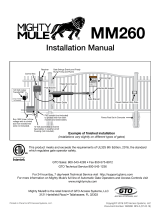 Mighty Mule MM260 User manual
Mighty Mule MM260 User manual
-
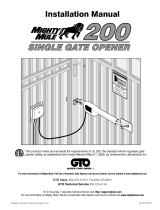 Mighty Mule FM200 Installation guide
Mighty Mule FM200 Installation guide
-
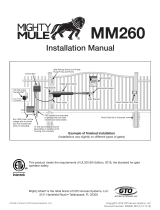 Mighty Mule MM260 Operating instructions
Mighty Mule MM260 Operating instructions
-
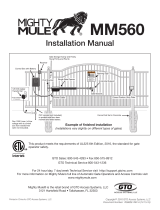 Mighty Mule Silver-HD Single Installation guide
Mighty Mule Silver-HD Single Installation guide
-
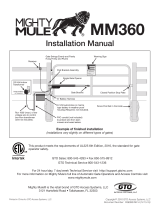 Mighty Mule MM360-SOL Operating instructions
Mighty Mule MM360-SOL Operating instructions
-
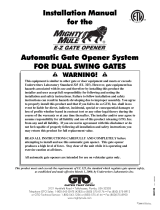 Mighty Mule Automatic Gate Opener System Installation guide
Mighty Mule Automatic Gate Opener System Installation guide
-
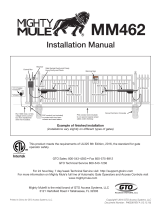 Mighty Mule MM462 Installation guide
Mighty Mule MM462 Installation guide
-
 Mighty Mule MMDIA30D Operating instructions
Mighty Mule MMDIA30D Operating instructions

















































